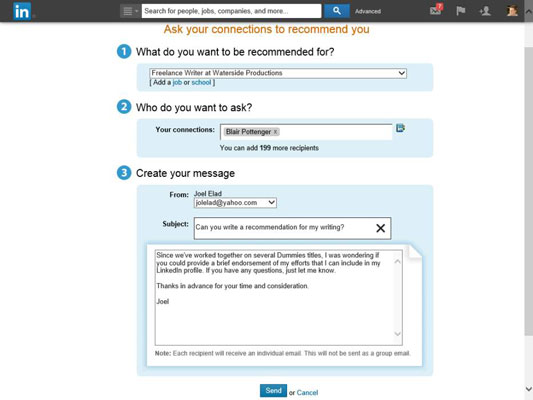In an ideal world, you’d never request a recommendation. A happy colleague or boss would just automatically post a raving recommendation on LinkedIn. But the reality is that most likely only your raving fans and very heavy LinkedIn users are going to make unsolicited recommendations.
Be prepared, though: Some people feel that recommendations should only be given freely, and they may be taken aback by receiving a recommendation request. So it’s imperative that you frame your request with a personal message, not just a generic message from LinkedIn.
Don’t be afraid to consider off-line methods of requesting a recommendation, such as a phone call or a face-to-face meeting, to make the request more personal and more likely for the person to say yes.
When you identify the person (or people) you want to write you recommendations, you’re ready to create a recommendation request. To get started on authoring your request, follow these steps:
Click the Profile link from the top navigation bar to bring up your profile. Click the drop-down arrow next to the Edit button (in your Summary box).
Click the Ask to Be Recommended link.
After the Ask for Recommendations page loads, click the drop-down arrow (right there at Step 1) to choose what you want to be recommended for from the list provided.

LinkedIn ties this recommendation to a particular position or school attended from your profile, so you need to select the position (or school you were attending) where the recommender observed you and is providing his recommendation.
Under the Who do you want to ask? header, type the name of the person you want to request a recommendation from into the Your Connections text field.

You can add the names of up to 200 people in this text field, and all will get a recommendation request.
If you click the little blue In icon to the right of the text box, LinkedIn opens up a new window containing the list of your connections, which you can select by selecting the check box next to someone’s name in the window.
As you start typing the name of the person, you should see that name pop up. Clicking the name adds it to the list of names visible in the Your Connections field. You can now type in another name if you would like to send this recommendation request to more than one person.
Type your message in the field provided.

The same etiquette is recommended here as in other requests: Don’t just accept the boilerplate text that LinkedIn fills in, but rather customize it to create a personal note. You can customize not only the body of your message, but the subject line as well.
Don’t forget to thank the person for the time and the effort in leaving you a recommendation!
Check your spelling and grammar.
You can write your message first using a program like Microsoft Word, run the Spelling & Grammar check, then cut and paste your message into the space provided, if you like.
Click Send.
The recommendation request is sent to the intended recipient.
Giving people some context as to why you’re making the request helps motivate them more effectively, especially if they’re nervous or unaware about how to use LinkedIn. Let them know you’re available for any technical or follow-up help.
Also, even though you should be asking only people who would be comfortable recommending you (you are, aren’t you?), you still want to give them a gracious way to decline. After all, you’re asking a favor. The person you’re contacting is in no way obligated, so don’t expect anything, and you won’t be disappointed.
There’s really no such thing as too many recommendations as long as the quality is good. Once you start accepting mediocre recommendations, though, on the assumption that something is better than nothing, people will start to think that a lot of them are fluff. LinkedIn doesn’t give you control over the display order, either, so you have all the more reason to make sure the recommendations displayed are good quality.





